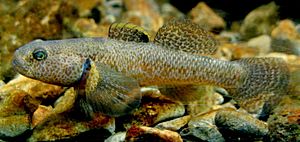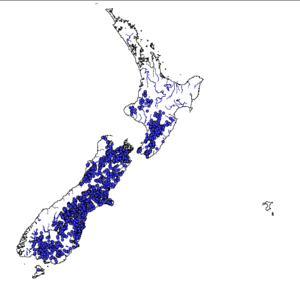Upland bully facts for kids
Quick facts for kids Upland bully |
|
|---|---|
 |
|
| Male upland bully (Gobiomorphus breviceps) | |
| Conservation status | |
| Scientific classification | |
 |
|
| Distribution of the upland bully | |
| Synonyms | |
|
The upland bully (Gobiomorphus breviceps) is a special type of fish. It lives only in fresh water in New Zealand. Both male and female upland bullies have cool orange-brown dots all over their heads. Most adult fish grow to be about 8 to 10 centimeters (3 to 4 inches) long.
Contents
What Does the Upland Bully Look Like?
Male upland bullies are usually bigger and stronger than females. They also have brighter markings. Their faces are covered with many orange spots. You can also see a creamy white stripe near their pectoral fins (these are the fins on their sides, like arms).
Colorful Fins
Just like other Gobiomorphus fish, male upland bullies have a colorful stripe on their first dorsal fin (the fin on their back). The color of this stripe can be different depending on where the fish lives. Many upland bullies have bright orange stripes. But some can have bright green, pink, yellow, or even cream-colored stripes. Some might not have a colored stripe at all!
Life Cycle of the Upland Bully
Upland bullies are not like some other fish that travel between fresh water and the sea. They stay in fresh water their whole lives. They do not migrate (travel long distances).
Building a Nest
During spring and summer, the male upland bully gets ready to become a dad. He finds a good spot, usually a hollow space under a rock, to make a 'nest'. He then protects this nest very carefully. Males like bigger nests. But if there are predators (animals that hunt them) nearby, they prefer smaller, more hidden nests. When a male is guarding his nest, his body color changes from brown to a very dark, almost black, color.
Laying and Guarding Eggs
When a female is ready to lay eggs, she swims into the male's nest. She turns upside-down and lays hundreds, sometimes even a thousand, tiny oval eggs. The eggs stick together in a single layer on the 'ceiling' of the nest. After she lays the eggs, the male fertilizes them. The female then leaves, and the male takes over. He guards the eggs until they hatch. This usually takes about two to four weeks. A female can lay eggs up to eight times during the spawning season. One male might even guard the eggs from more than one female!
Young Fish
When the baby fish, called fry, hatch, they grow up in calm, still waters near the edges of streams. They can start having their own babies when they are about one year old. Upland bullies usually live for about 3 to 4 years.
Where Do Upland Bullies Live?
Upland bullies are found in many places across the South Island of New Zealand. However, there are some areas on the west coast where they are not found, like around the Tasman Mountains and south of Hokitika. They also live in the bottom half of the North Island. You can find them from the start of the Mokau River in the west to southern Hawke's Bay in the east. They are also present on Stewart Island.
Different Groups of Fish
Scientists have found that there are five different groups of upland bullies based on their genes and where they live. The biggest and most unique group lives along most of the east coast of the South Island. The other four groups are closely related. They are found in the north of the South Island and in the North Island. During the ice ages, the North and South islands were connected by land. This allowed upland bullies from the north of the South Island to spread further north. The upland bullies in the large southern group are often bigger and have bolder patterns than the ones in the northern groups.
Upland bullies can live far inland, away from the coast, as well as closer to the sea. They can handle many different water conditions. However, they prefer water that flows slowly.


